Other common names: charlock, jointed radish, wild turnip, jointed charlock, white charlock, wild kale, cadlock, runch, jointed wild radish
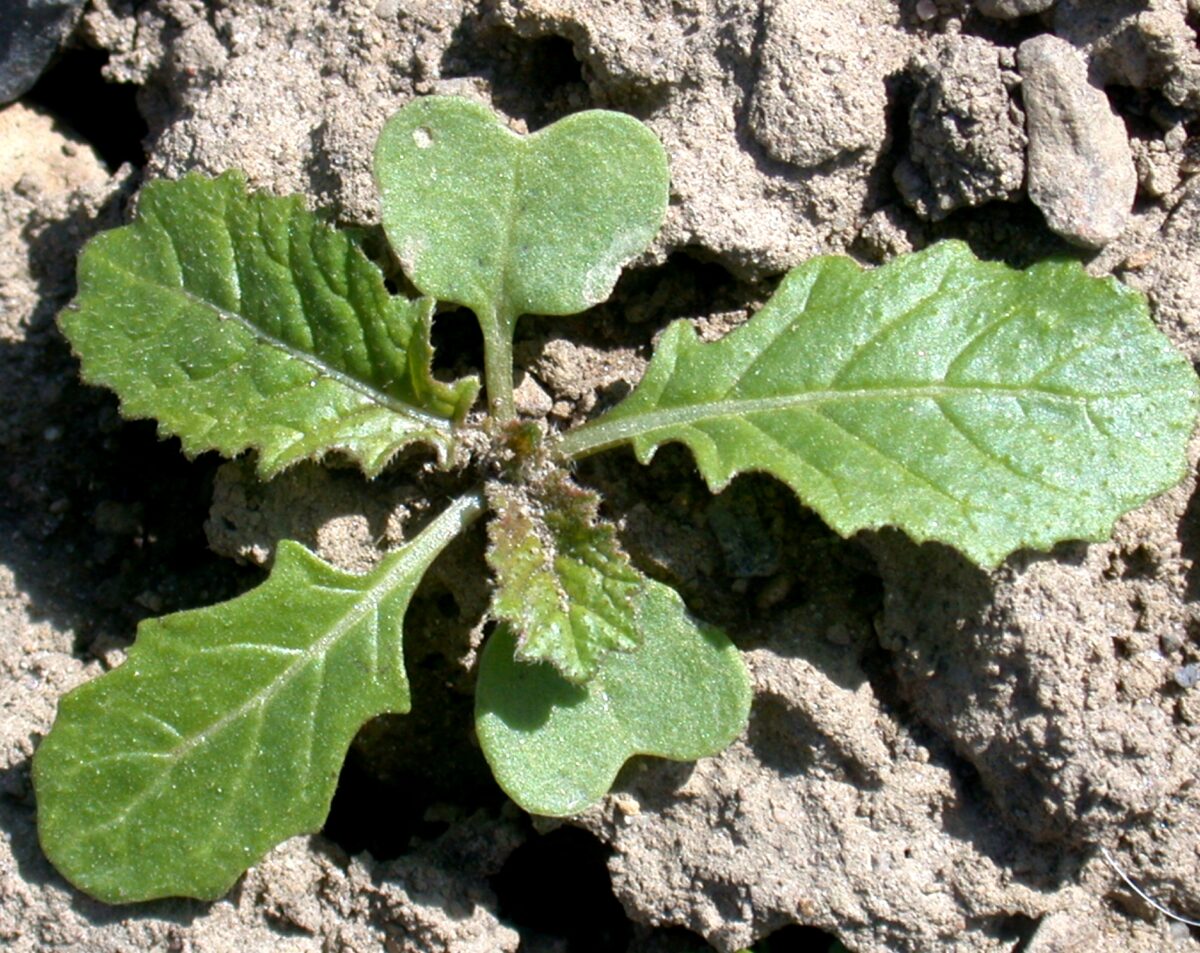
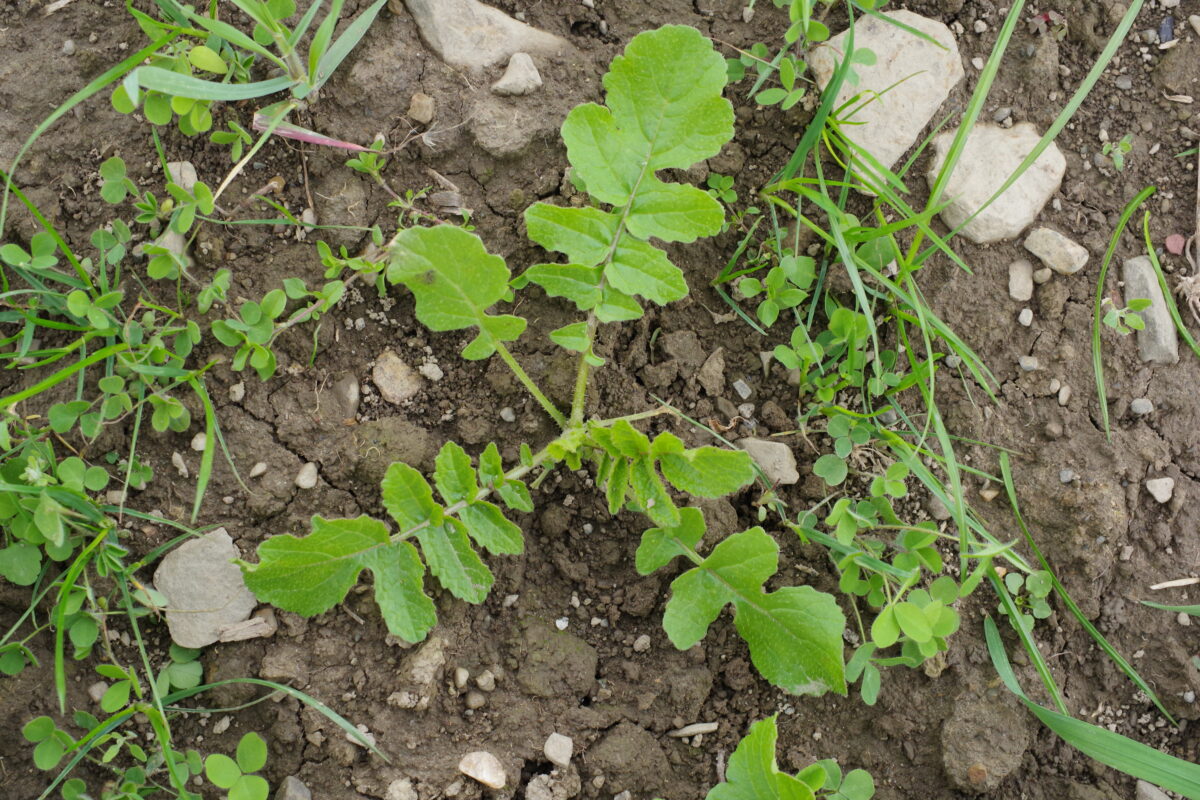
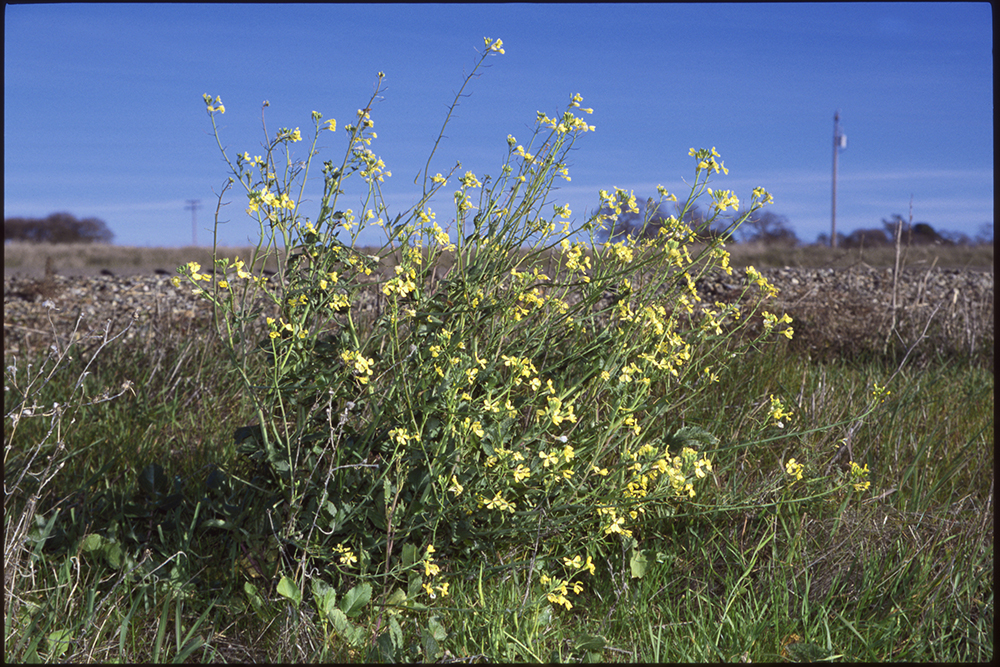
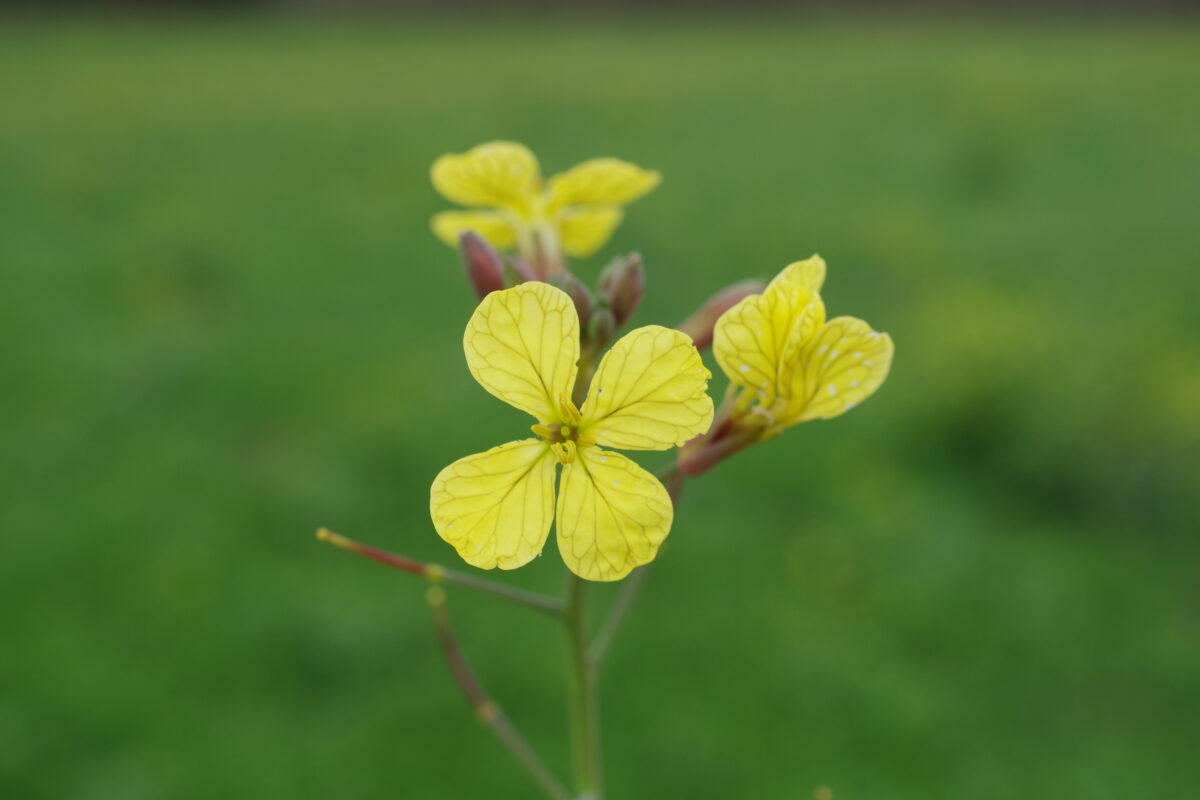
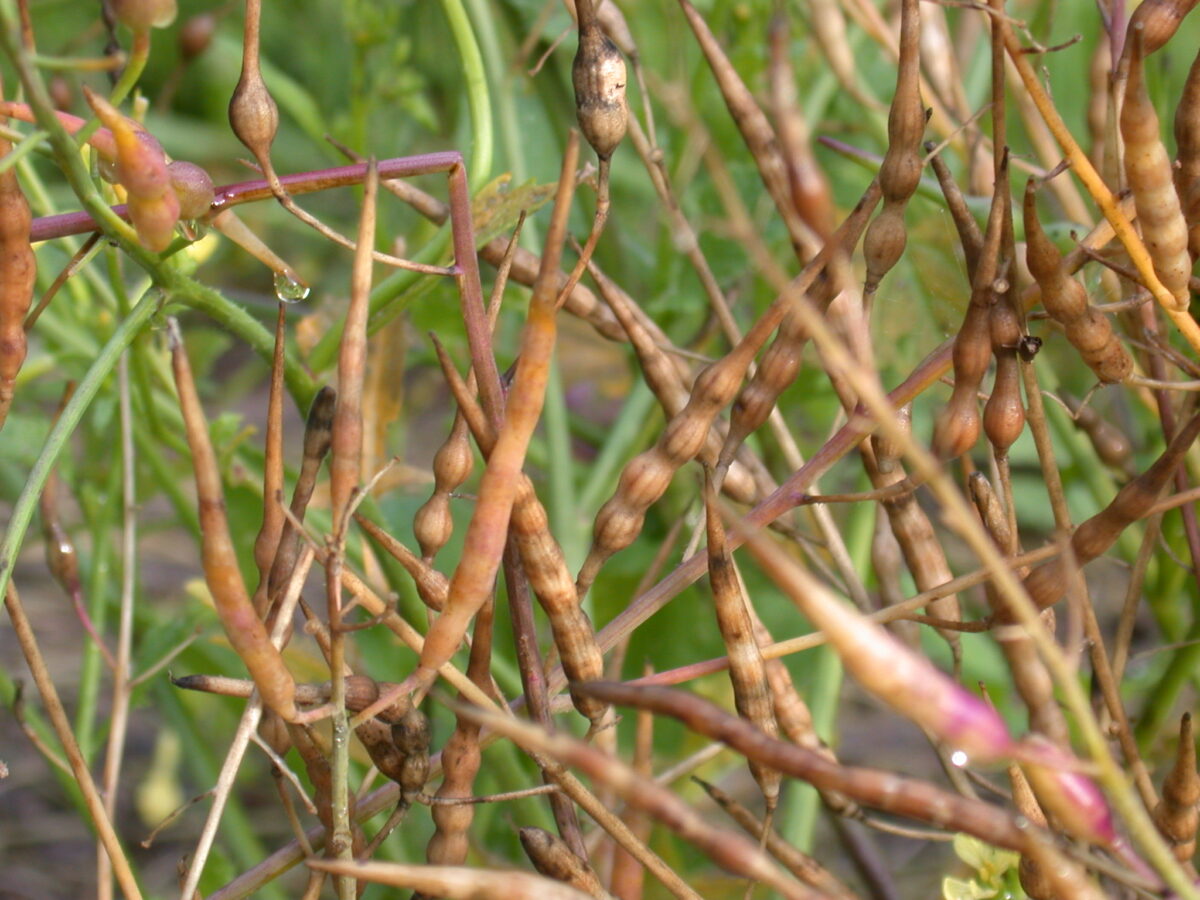
Raphanus raphanistrum L.
Identification of Wild Radish
Family: Mustard family, Brassicaceae
Habit: Winter or summer annual herb bolting from a rosette
Description: Seedling stems below cotyledons are purple and have stiff hairs. Cotyledon blades are hairless, kidney shaped to heart shaped with the indentation at the tip, 0.4–0.8 inch long and slightly wider than long, and prominently veined. Cotyledon stalks are 0.4–1 inch long and tapered. First leaves are oval to oblong, alternate, long stalked and strongly veined with wavy, lobed and irregularly toothed edges. The largest lobe occurs at the leaf tip, with two to four smaller lobes near the base. Stiff hairs are scattered on both leaf surfaces and on leaf edges. Early leaves form a basal rosette. Mature plants bolt from the rosette, producing a 1–4 foot tall, branched stem. Stems are densely hairy at the base but more sparsely hairy toward the top. Lower leaves are 2–8 inches long by 2 inches wide, oval to oblong and long stalked. Leaf edges are irregularly toothed and lobed like the young leaves. Upper leaves are stalkless or short stalked, lanceolate and smaller (less than 3 inches long). Edges are entire to toothed, with zero to five lobes at base. All leaves have coarse, stiff hairs scattered on edges and on both surfaces. The sturdy taproot has a strong radish scent. Flowers occur in branched clusters at the ends of the stem and branches. Individual flowers are 0.4–0.5 inch wide with four petals and are pale yellow to cream colored or white. Petals usually have distinctive purple veins. (Note that purple-pink flowers have been observed and are speculated to be the result of crossing with cultivated radish.) Flower stalks are upright and 0.25–1 inch long. Seedpods form below the flowers and are initially cylindrical, green and fleshy; they are 0.8–3 inches long with a 0.4–2 inch-long beak and contain two to 10 seeds. As seedpods ripen, they become brown, corky and ridged lengthwise, and constricted joints develop between the seeds. Seedpods break into segments at the joints when seeds are mature; individual segments do not open. Seeds are grooved, red-brown, 0.1–0.25 inch long by 0.06–0.1 inch wide and kidney shaped.
Similar species: Cultivated radish (Raphanus sativus L.) is very similar to wild radish but has pink to purple flowers and unjointed seedpods with only two to three seeds. Wild mustard (Sinapis arvensis L.) and other mustard species do not have purple-veined petals and have seedpods that split when mature rather than break into segments. Seeds are almost perfect spheres compared to wild radish seeds. Wild radish leaves are hairier, rougher and more lobed than wild mustard, and the latter does not form a basal rosette. Leaves of yellow rocket (Barbarea vulgaris W. T. Aiton) are glossy, dark green and are not hairy like those of wild radish.
Management of Wild Radish
If wild radish is a problem, lime to pH 6.8 and avoid applying excess N. Time applications of soluble N sources to correspond to periods of high crop uptake. Because wild radish has a persistent seed bank, the suggestions below for reducing seed density will likely require a few years to have a major impact.
In grain crops, use a tine weeder with stiff tines to break or bury as many wild radish plants as possible since the taproot and deep emergence makes seedlings resistant to uprooting. Since the pods often do not shatter until wheat or canola harvest, consider setting the combine to collect wild radish seeds with the grain, and then clean it out later. This will greatly reduce seed return, and if wild radish is a problem, the grain will likely need secondary cleaning anyway. In warm climates where wild radish acts as a winter annual, till very shallowly (1–2 inches) to stimulate germination and then till again to eliminate seedlings prior to planting grain crops. A single cycle of tillage and incorporation is likely to be as effective as several. In corn or soybeans, use a guidance system or belly mounted cultivator to get as close as possible to the row with shallow-pitched sweeps running close to the soil surface. This will cut off the young wild radish with minimum damage to crop roots. Hill up corn and soybeans before wild radish seedlings get too large for complete burial.
In vegetable crops, use side-knives to get as close to the row as possible. In-row weeding machines or hand hoeing will be necessary to obtain good control. Wild radish can pose a severe problem if soil is kept acidic for potato production. Mound about 2 inches of soil over the rows after planting potatoes; then tine weed aggressively when wild radish seedlings appear, and, if necessary, repeat until the potato vines emerge. The aggressive tine weeding will flatten out the field. Hill potatoes in multiple operations to bury successive flushes of wild radish while they are still short. Rather than mowing vines before harvest, use a forage harvester to blow the chopped plants and seedpods into a wagon for disposal.
Where wild radish acts as a summer annual, use a short tilled fallow in spring to reduce seed density before planting a late spring or summer crop. Wild radish may not be very competitive in a summer crop, but this will reduce density in the next spring planted crop. Where wild radish acts as a winter annual, use a late winter to very early spring tilled fallow to flush seeds out of the soil before spring planted crops. This will not help the spring crop because it will have few wild radish anyway, but the fallow will reduce wild radish density in later cool season crops.
If an exceptionally severe infestation of wild radish cannot be prevented from dropping seed, let the seeds weather on the soil surface until the next crop. Then moldboard plow deeply (10 inches). In subsequent years, use direct drilling or shallower tillage (less than 6 inches) to avoid bringing remaining seeds to the surface.
Inspect grain seed for wild radish pod segments before sowing. Pay particular attention to rye seed sold for use as a cover crop or forage that has not been certified for quality.
Ecology of Wild Radish
Origin and distribution: Wild radish is native to the Mediterranean regions of Europe, North Africa and the Middle East. It has been introduced widely in Asia, Australia, Latin America and South Africa, and it is a serious weed in grain growing parts of those regions. It is generally rare or absent in the humid tropics. It occurs widely in North America but is rare or absent in much of the center of the continent. As a weed, wild radish causes the greatest problems in the Canadian Maritime provinces, the eastern seaboard and the Pacific coast.
Seed weight: Population mean seed weights for field grown plants range from 5.3–8.6 mg. Seed weight within the same fruit can vary from 1.5–12 mg, and seeds are heaviest in pods with few seeds. Larger seeds had the highest germination, growth and reproductive output.
Dormancy and germination: Freshly produced wild radish seeds are usually dormant, although seeds from plants that emerge in fall are more dormant than those that emerge in spring. Dormancy is caused both by a germination inhibitor in the seed coat and by physical restriction from the woody pod segment that usually remains attached to the seed. After-ripening for six months or burial in the soil over winter generally breaks dormancy. Exposure of seeds to high moisture and fluctuating temperatures appears to facilitate germination by breaking down the pod and seed coat. In some warm climate populations where the species behaves as a winter annual, exposure of seeds on the soil surface during the summer breaks dormancy, and dormancy is lowest in fall but progressively increases from winter to summer months. In this case, cold stratification increases dormancy. Germination in fall is higher from buried seeds than from seeds on the soil surface. Optimum temperature for wild radish germination is 39–68°F and improves with alternating temperatures within this range. Light has minimal effect on germination and can be suppressive at low temperatures.
Seed longevity: Some wild radish seeds remain viable in soil for up to 15–20 years. In a five-year experiment in which the top 3 inches of soil were seeded and then stirred twice each year, the number of seeds declined by 29% per year. This was similar to the 33% per year decline in the seed bank during the first two years under a grass sod. In Australia, the number of viable seeds declined by 32% in one year when buried at 4 inches.
Season of emergence: In northern areas the species emerges primarily in the spring. In the southern parts of the United States, seedlings emerge all year, with peak emergence in fall and winter.
Emergence depth: Most seedlings emerge from the top 1.2 inch of soil, but a few can emerge from as deep as 2.8 inches. Twice as many seedlings emerge from 0.4 inch as from the soil surface. When seeds were sown and tilled into the soil, average depth of seedling emergence was 1.1 inch with a range from 0.3–1.5 inch.
Photosynthetic pathway: C3
Sensitivity to frost: Seedlings are killed by sub-freezing temperatures, but young rosettes are frost hardy, and the species commonly acts as a winter annual in the southern United States. Frost kills mature plants.
Drought tolerance: The rarity of wild radish in the interior of North America is attributed to a lack of drought tolerance. In California, a moisture deficit in the spring caused more adverse effects than a moisture deficit in the fall.
Mycorrhiza: Wild radish is a poor mycorrhizal host, possibly because of anti-fungal compounds excreted from roots.
Response to fertility: Wild radish is often associated with nitrogen rich soils. In high N soils, wild radish will take up more N than it needs for growth and stores it as nitrate. If N is less available later in the life cycle, plants will use the previously stored nitrate to make proteins. In one chamber experiment, Nitrogen fertilizer increased vegetative growth but not reproductive growth. Liming soil to increase the pH from 6 to 6.8 was a major factor contributing to decreased abundance of wild radish in an 11-year study.
Soil physical requirements: Wild radish can occur on all soil types, including sand, clay, sandy loam and chalky or saline soil, but it appears to do best on acidic sandy soils.
Response to shade: Wild radish grows best in high light. Late emerging plants bypass the rosette stage and bolt early. Wild radish height and the ratio of leaf area to leaf weight are greater under a wheat canopy than in the open, but overall biomass and potential seed production is reduced, especially for later emerging cohorts.
Sensitivity to disturbance: Cutting and grazing have minimal effect on wild radish seed production because of its ability to rapidly produce new flowering stems. Plants have a highly branched stem structure that favors recovery from cutting. Also, multiple stems can form from buds at the base of rosette leaves when resources are adequate.
Time from emergence to reproduction: In Ontario, spring emerging wild radish begins flowering in three to six weeks, but seeds do not mature until August. Plants emerging in Wisconsin took seven weeks to mature. Plants mature most rapidly in warm weather, and plants emerging in June in South Carolina required 44 days to mature whereas plants emerging in November required 231 days. In Western Australia, where the climate is similar to that of California, plants emerging in the fall took 90 days to flower and successively later emerging plants required shorter periods down to 49 days for plants emerging in the spring. Under rapid developmental conditions in Australia, viable seeds can form within pods three weeks after flowering. The flowering period of wild radish in Quebec sufficiently overlaps that of canola for gene flow to potentially occur from herbicide-resistant canola to wild radish.
Pollination: Wild radish cannot self-pollinate. It is cross pollinated primarily by bees, butterflies and syrphid flies.
Reproduction: Plants produce up to 10,000 seeds per plant, depending on region, competition and the time of emergence. Plants in spring wheat in Quebec produced 50–150 seeds per plant, with early emerging individuals producing the most seeds. In northern areas, plants continue to flower and produce seeds until killed by frost. In South Carolina, fertilized, well-watered plants grown with minimal competition produced 8,000–10,000 seeds when emerging in April, October or November, but less than 2,000 when emerging in June or July. Plants grown with wheat in Australia produced up to 1,000 seeds per plant.
Dispersal: Seeds naturally disperse within 1–3 feet of the parent plant. Seeds may move greater distances in soil clinging to tires and machinery or in harvesting equipment. Pod segments, each containing a single seed (sometimes two), are similar in size to cereal grain and are sometimes sown with seed grain. Plants are attractive to grazing mammals, and the seeds pass through to disperse in manure.
Common natural enemies: Wild radish is eaten by grazing mammals and rodents.
Palatability: Some people in the Mediterranean region and Pakistan eat the leaves in salads or cooked. Livestock find young plants palatable, but eating large quantities of wild radish (more than 25% of the diet) can cause sickness. The seeds are especially toxic.
Note: Green manure that included ground-up plants of wild radish suppressed emergence and growth of several crops and weeds in South Carolina.
Summary Table of Wild Radish Characteristics
| Wild Radish | ||||||||
|---|---|---|---|---|---|---|---|---|
| Growth habit | Seed weight (mg) | Seed dormancy at shedding | Factors breaking dormancy | Optimum temperature for germination (F) | Seed mortality in untilled soil (%/year) | Seed mortality in tilled soil (%/year) | Typical emergence season | Optimum emergence depth (inches) |
| medium, branched | 2–12 | Yes | cms, at | 39–68 | 32–33 | 29 | spring and fall/winter | 0.4–1.2 |
| Photosynthesis type | Frost tolerance | Drought tolerance | Mycorrhiza | Response to nutrients | Emergence to flowering (weeks) | Flowering to viable seed (weeks) | Pollination | Typical & high seed production (seeds per plant) |
| C3 | high | low | no | high | 3–7 | 3–4 | cross | 500 & 10,000 |
Table Key
General: The designation “–” signifies that data is not available or the category is not applicable.
Growth habit: A two-word description; the first word indicates relative height (tall, medium, short, prostrate) and second word indicates degree of branching (erect, branching, vining).
Seed weight: Range of reported values in units of “mg per seed.”
Seed dormancy at shedding: “Yes” if most seeds are dormant when shed, “Variable” if dormancy is highly variable, “No” if most seeds are not dormant.
Factors breaking dormancy: The principle factors that are reported to break dormancy and facilitate germination. The order of listing does not imply order of importance. Abbreviations are:
scd = seed coat deterioration
cms = a period subjected to cold, moist soil conditions
wst = warm soil temperatures
li = light
at = alternating day-night temperatures
ni = nitrates
Optimum temperature range for germination: Temperature (Fahrenheit) range that provides for optimum germination of non-dormant seeds. Germination at lower percentages can occur outside of this range. The dash refers to temperature range, and the slash refers to alternating day/night temperature amplitudes.
Seed mortality in untilled soil: Range of mortality estimates (percentage of seed mortality in one year) for buried seeds in untilled soil. Values were chosen where possible for seeds placed at depths below the emergence depth for the species and left undisturbed until assessment. Mortality primarily represents seed deterioration in soil.
Seed mortality in tilled soil: Range of mortality estimates (percentage of seed mortality in one year) for seeds in tilled soil. Values were chosen for seeds placed within the tillage depth and subjected to at least annual tillage events. Seed losses are the result of dormancy-breaking cues induced by tillage, germination and deterioration of un-germinated seeds.
Typical emergence season: Time of year when most emergence occurs in the typical regions of occurrence for each weed. Some emergence may occur outside of this range.
Optimum emergence depth: Soil depths (in inches below the soil surface) from which most seedlings emerge. Lower rates of emergence usually will occur at depths just above or just below this range.
Photosynthesis type: Codes “C3” or “C4” refer to the metabolic pathway for fixing carbon dioxide during photosynthesis. Generally, C3 plants function better in cooler seasons or environments and C4 plants function better in warmer seasons or environments.
Frost tolerance: Relative tolerance of plants to freezing temperatures (high, moderate, low).
Drought tolerance: Relative tolerance of plants to drought (high, moderate, low).
Mycorrhiza: Presence of mycorrhizal fungi. “Yes” if present; “no” if documented not to be present, “unclear” if there are reports of both presence and absence; “variable” if the weed can function either with or without, depending on the soil environment.
Response to nutrients: Relative plant growth response to the nutrient content of soil, primarily N, P, K (high, moderate, low).
Emergence to flowering: Length of time (weeks) after emergence for plants to begin flowering given typical emergence in the region of occurrence. For species emerging in fall, “emergence to flowering” means time from resumption of growth in spring to first flowering.
Flowering to viable seed: Length of time (weeks) after flowering for seeds to become viable.
Pollination: “Self” refers to species that exclusively self-pollinate, “cross” refers to species that exclusively cross-pollinate, “self, can cross” refer to species that primarily self-pollinate, but also cross-pollinate at a low rate, and “both” refers to species that both self-pollinate and cross-pollinate at relatively similar rates.
Typical and high seed production potential: The first value is seed production (seeds per plant) under typical conditions with crop and weed competition. The second value, high seed production, refers to conditions of low density without crop competition. Numbers are rounded off to a magnitude that is representative of often highly variable reported values.
Further Reading
Cheam, A.H. 1986. Seed production and seed dormancy in wild radish (Raphanus raphanistrum L.) and some possibilities for improving control. Weed Research 26: 405–413.
Cheam, A.H. and G.R. Code. 1995. The biology of Australian weeds. 24. Raphanus raphanistrum L. Plant Protection Quarterly 10: 2–13.
Del Monte, J.P., J. Dorado and C. Lopez-Fando. 1999. Weed seed bank response to crop rotation and tillage in semiarid agroecosystems. Weed Science 47: 67–73.
Warwick, S.I. and A. Francis. 2005. The biology of Canadian weeds. 132. Raphanus raphanistrum L. Canadian Journal of Plant Science 85: 709–733.

